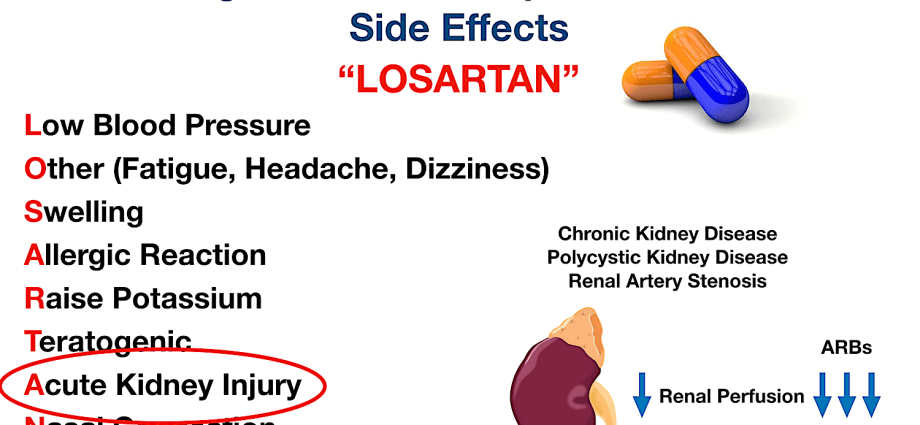Contents
Sartans are drugs that are used in the treatment of high blood pressure. They are prescribed by doctors most often when a cough occurs while taking angiotensin converting enzyme inhibitors (first-line drugs for the treatment of high blood pressure). This is a very characteristic side effect of taking these drugs, and sartans are devoid of them. What is the mechanism of action of sartans and are they effective in the treatment of hypertension?
For therapeutic action sartans active substances such as: losartan, candesartan, irbesartan, eprosartan, or recently withdrawn from the market – valsartan are responsible. Sartany They are drugs generally well tolerated by the body, do not cause many side effects, but compared to the commonly used in the treatment of arterial hypertension, angiotensin converting enzyme inhibitors have a slightly weaker effect. Sartany have a fairly long half-life, so they are taken once a day, regardless of meals, preferably at the same time.
Sartany – mechanism of action
Angiotensin II is a substance that strongly increases blood pressure. The smooth muscles of the blood vessel walls contract, which causes their narrowing and the hypertensive effect (increase in blood pressure). Angiotensin IIacting on the cardiovascular system, it increases the stroke volume of the heart, increases vascular resistance and increases the heart rate. It also acts on the pituitary gland, from which the release of the antidiuretic hormone is increased in the posterior lobe. This in turn causes an increase in thirst and a decrease in appetite. Angiotensin II arises as a result of the action of renin in the kidney. It converts angiotensinogen into angiotensin I, which in turn is converted into angiotensin II (due to the action of angiotensin converting enzyme, an enzyme which is blocked by angiotensin converting enzyme inhibitors). Angiotensin II stimulates the biosynthesis of aldosterone in the adrenal cortex, as a result of which water is retained in the body and blood pressure rises. Sartany are also known as angiotensin receptor antagonists because they prevent it from binding angiotensin II to this receptor. This has the effect of blocking the biological action angiotensin II – it is produced but cannot attach to the receptor.
The use of sartans and cough
Patients using angiotensin converting enzyme inhibitors often complain of the appearance of a dry, persistent cough when using them. However, this side effect does not apply to users sartany. What is the cause of this phenomenon? The mechanism of action of both groups of drugs. Converting enzyme inhibitors inhibit the conversion of angiotensin I to angiotensin II by inactivating the enzyme that catalyzes this reaction. However, the enzyme in question – angiotensin converting enzyme – is also responsible for the breakdown of certain substances. This is especially true of bradykinin, a tissue hormone that is present in the lungs and is broken down by the enzyme. Inhibition of ACE also leads to the accumulation of bradykinin in the lungs, which results in attacks of dry cough. Use sartans does not cause such a phenomenon, because the action of angiotensin converting enzyme is not blocked, thus – there is no accumulation of bradykinin in the lungs. Sartany because they only work at the receptor level. However, since angiotensin II is produced anyway, sartany they are slightly weaker than angiotensin converting enzyme inhibitors.
Sartany – indications for use
Sartany they are used in the treatment of essential arterial hypertension in adults, children from 6 years of age, and are also used as drugs to normalize the disturbed systolic function of the left ventricle. Sartany they are also prescribed by doctors when a patient responds poorly to ACE inhibitors.
Sartans – contraindications to use
Medicines from the group sartans pregnant women should absolutely not be used, especially in the second and third trimesters and during breastfeeding. However, if it is necessary to use medications to lower blood pressure during pregnancy or lactation, consult your doctor who will adjust the treatment and change the medications.
Sartans – side effects
Regarding side effectsthat may or may not be caused by drugs from the group sartansmost often they relate to central disorders, e.g. headaches and dizziness. It happens because sartany they also act on the angiotensin receptors found in the brain (AT1 receptors). Sartans, however, can also affect the labyrinth and thus lead to imbalances. Among the frequently mentioned side effects respiratory infections are also found. On the other hand, there is very rarely an increase in potassium in the blood (hyperkalaemia) and a decrease in sodium (hyponatraemia). Drugs of the group sartans when taken orally, they undergo a first-pass effect, which means that they are transformed in the liver. This is usually an unfavorable process and causes the liver enzymes to increase in sartans.










